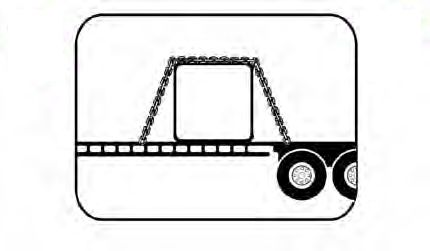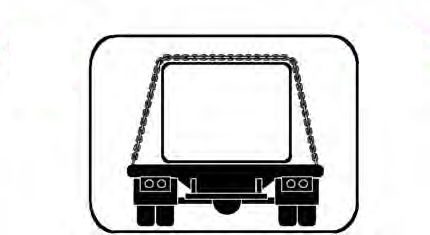CDL Practice Tests: Dominate The CDL Exam!
Choose A Section:
Go!In cargo securement, the deck is:
- A rail along the side of a vehicle that protects the side of the vehicle from impacts.
- The load carrying area of a truck, trailer, or intermodal container.
- A vertical barrier placed directly behind the cab of a tractor to protect the cab in the event cargo should shift forward.
- Part of the structure, fitting, or attachment on a vehicle or cargo to which a tiedown is attached.
Deck:
The load carrying area of a truck, trailer, or intermodal container.
When a vehicle goes around a corner, the rear wheels follow a different path than the front wheels. This is called:
- Rolling over
- Off-tracking
- Inner-tracking
- Turn scraping
What is the minimum angle that indirect tiedowns must form with the vehicle?
- 90 degrees.
- 45 degrees.
- 30 degrees.
- 180 degrees.

An indirect tiedown that is used to prevent front-to-back cargo movement must make an angle of at least 30 degrees with the deck when viewed from the side of the vehicle.

An indirect tiedown that is used to prevent side-to-side movement must make an angle of at least 30 degrees when viewed from the front or back of the vehicle.
If the coolant recovery container is not part of the pressurized system:
- Never try to add coolant to any cooling system when the engine is hot, regardless of the type of coolant recovery container
- The radiator cap is more prone to leakage in this type of system, so check it often
- The operating temperature in this type of system will be higher than in most
- The cap can be safely removed and coolant added even when the engine is at operating temperature
Some vehicles have sight glasses, see-through coolant overflow containers or coolant recovery containers. These permit you to check the coolant level while the engine is hot. If the container is not part of the pressurized system, the cap can be safely removed and coolant added even when the engine is at operating temperature.
Working Load Limit (WLL)is defined as:
- The maximum load that may be applied to a component of a cargo securement system during normal service, usually assigned by the manufacturer of the component.
- The summation of the working load limits or restraining capacity of all devices used to secure an article on a vehicle.
- The number of hours that a tiedown can be used.
- The acceleration due to gravity, 9.823 m/sec2 (32.2 ft/sec2).
Working Load Limit (WLL):
The maximum load that may be applied to a component of a cargo securement system during normal service, usually assigned by the manufacturer of the component.
Define "Braking Distance":
- The distance you will continue to travel, in ideal conditions; before you physically hit the brakes in response to a hazard seen ahead.
- The total minimum distance your vehicle has traveled, in ideal conditions, with everything considered, until you can bring your vehicle to a complete stop.
- The distance your vehicle will travel in ideal conditions, while you are braking.
- The distance your vehicle travels, in ideal conditions, from the time your eyes see a hazard until your brain recognizes it.
Braking Distance. The distance your vehicle will travel, in ideal conditions, while you are braking. At 55 mph on dry pavement with good brakes, it can take about 216 feet.
You wake up and do your pre-trip inspection at 6:00 am. You do a mix of driving and on-duty work throughout the day. At 8:00 pm you're parked on the dock and finished driving for the day. The dock workers want you to come inside and count freight as they load your truck. According to the 14-hour rule, can you legally do this, and why?
- Yes, you can legally work after your 14-hour window has passed because you didn't drive the entire 14 hours. You mixed in some on duty time so that means you can drive or work after the 14-hour window.
- No, you can not legally work after the 14-hour window until you get 10 consecutive hours off duty
- No, you can not legally work after the 14-hour window unless you have less than 2 hours of drive time remaining to get to your destination. Since you are at the destination already, you must not work until you get 10 consecutive hours off duty
- Yes, you can legally work after your 14-hour window has passed, but you can not drive again until you get 10 consecutive hours off duty.
Which of the following is not a requirement for shortwood loaded lengthwise?
- Logs should be centered in the bunk.
- Each outside log bearing against stakes should extend at least 6 in beyond the stakes at each end.
- Heavier logs must be stacked on top.
- Must be cradled in a bunk or contained by stakes.
Requirements for shortwood loaded lengthwise
- Shortwood must be cradled in a bunk or contained by stakes.
- Logs should be centered in the bunk.
- Each outside log bearing against stakes should extend at least 0.15 m (6 in) beyond the stakes at each end.
The Emergency Response Guidebook is indexed by:
- Proper shipping name and hazardous materials identification number
- Placarding status and reportable quantity index
- National Hazardous Materials serial number and United Nations response index
- United Nations hazardous materials index number
9.7.1 - Emergency Response Guidebook (ERG)
The Department of Transportation has a guidebook for firefighters, police and industry workers on how to protect themselves and the public from hazardous materials. The guide is indexed by proper shipping name and hazardous materials identification number. Emergency personnel look for these things on the shipping paper. That is why it is vital that the proper shipping name, identification number, label and placards are correct.
Which of the following is not an acceptable method of containing loose parts when securing flattened or crushed vehicles?
- Suitable covering material.
- Sideboards or sides.
- Wedge them in between the flattened cars.
- Structural walls.
Containing Loose Parts
Use a containment system that:
- Prevents loose parts from falling from all four sides of the vehicle AND
- Extends to the full height of the cargo.
The containment system can consist of one or a combination of the following methods.
- Structural walls.
- Sides or sideboards.
- Suitable covering material.
The use of synthetic material for containment of loose parts is permitted.
CDL Manual Sections To Choose From:
- Introduction
- Driving Safely
- Transporting Cargo Safely
- Transporting Passengers Safely
- Air Brakes
- Combination Vehicles
- Doubles and Triples
- Tank Vehicles
- Hazardous Materials
- School Bus
- Vehicle Inspection
- Basic Vehicle Control Skills Test
- On-Road Driving
- Logbook
- Weight And Balance
- Flatbed Cargo Securement
- New York State Coil Endorsement
CDL Practice Tests
Our CDL practice tests are designed to help test your knowledge of the CDL Manual and sharpen your skills for taking the CDL permit and endorsement exams. They are not designed to teach you the knowledge necessary to pass the exams. Please do not try to memorize CDL practice tests in order to get your CDL. There's a better way.
Our High Road CDL Training Program is by far the easiest and most effective way to learn the materials necessary for passing your written CDL exams and preparing for a great start to your career. We strongly suggest using the High Road (which is 100% free!) to learn the CDL manual before using our CDL practice questions to test your knowledge.
How to Pass CDL Permit Test the First Time
The Class A CDL permit exam consists of a multiple choice test covering 20 different areas related to commercial driving. To prepare for this test, it is important to do practice tests beforehand. Knowing your personal study habits, getting enough rest, and eating a healthy breakfast will also set you up for success.
Tips For Passing the Commercial Driver's License (CDL) Permit Test
- Practice Makes Perfect: The best way to both mentally and physically prepare for the written exam is to take practice tests. Start out with open-book tests and gradually work your way up to giving yourself a time limit. Finally, before the big day, take a practice exam as if it were the real thing without any help. This will give you a good indication of how well you understand the material.
- Understand Instead of Memorize: Memorizing information can be helpful for the written exam, but the key to being fully prepared is to understand the material rather than just memorizing it. Understanding the material will allow you to answer questions correctly no matter how they are worded.
- Real World Applications: When struggling to understand concepts, create real-world scenarios to make the information more relevant to your life. Doing this will make it easier to remember come test time.
- Utilize Study Strategies: Utilizing study strategies such as flashcards, songs, rhymes, and phrases can help you remember the material.
- Be Fresh and Alert: The night before the exam, get a good night's sleep and eat a filling breakfast on the morning of the exam. This will ensure you are fresh and alert to take your exam.
- Begin Early and Space out Your Studying: It is important to give yourself ample time before the exam to get familiar with the material and get your mind ready for the big day. Consider taking a training course online or in-person, if it's required. Shop around for a course that works best for you. By following these tips, you will be well prepared for your written CDL exam and on your way to a successful career.







 TT On Facebook
TT On Facebook